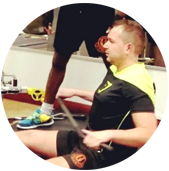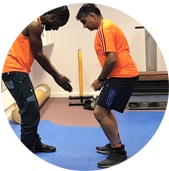gymantix calisthenics
Calisthenics are a form of bodyweight exercise that create a strong foundation for improved fitness
Calisthenics are bodyweight exercises in which your body’s relationship with gravity creates the resistance. These movements are fundamental for athletes from all walks of life and at all levels of experience. Calisthenic exercises incorporate aspects of balance and coordination, resistance, and mobility to help you build strength and muscular endurance.
Simplicity is a good word to describe calisthenic exercises. This type of training uses all the classics— air squats, push-ups, pull-ups, etc.,— with increased intensity and advanced positions over time. While bodyweight training might sound like a basic exercise, that doesn’t make it easy.
Bodyweight training is versatile, with variations and modifications to make the movement more accessible to beginners or more intense for progression. Once you have good comprehension of these movements and their variations, you can structure your workouts to develop all of your body parts while experiencing a wide range of benefits.
How To Start Calisthenics Workouts?
The way to begin your bodyweight journey is to learn the basics. Of course, you have push-ups, pull ups, air squats, hamstring curls, handstand push-ups or pike push-ups, dips, and Australian pulls, and sprints. (Don’t worry, these will be covered in depth later.) With a few key movements, you can create a workout plan based on those and their respective variations.
For the first week or so, familiarize yourself with these bodyweight movements. Some of them might be a bit awkward when you’re just starting out, but that’s only because there’s zero muscle memory. Once you get the hang of the classics, up the reps and challenge yourself until it’s time to learn a new, harder variation.
The best way to structure a calisthenics workout schedule is to group together similar body parts: push muscles and pull muscles or upper body and lower body. You can work these as often as you want, put two of them together on the same day, or go full body three times a week.
The important thing to remember is you’ll want to target each group of muscles every 48-96 hours or so, to maximize muscle and strength gains while allowing your body to rest and recover.
A great reason to go with calisthenics as your workout of choice is the equipment needed. What you need is:
Your body
Floor space
A horizontal bar that’s just out of reach above you. If you don’t have a park or bar near you, we recommend one of these outdoor pull up bars for good weather days.
A set of parallel bars at hip height
That’s the basics, though you can get away with just your body and some room to move to start. That will cover your push exercises and abdominal movements, as well as most leg work. The horizontal bar is needed for both pulling work and hanging ab exercises. And the short parallel bars are mainly used for dips and Australian pulls.
These items can be found at any local park, school gymnasium, or you could even make your own set in your backyard! The fact that you can find a monkey bar setup and parallel bars for free in your neighborhood is a wonderful way calisthenics can give you the gift of fitness on the cheap.






